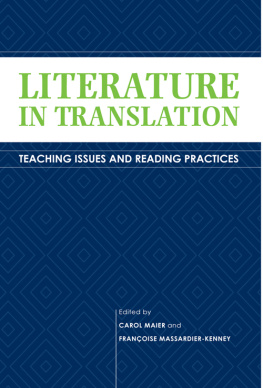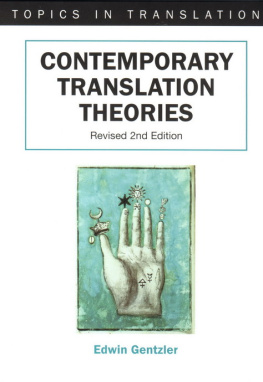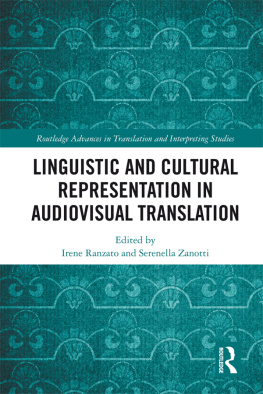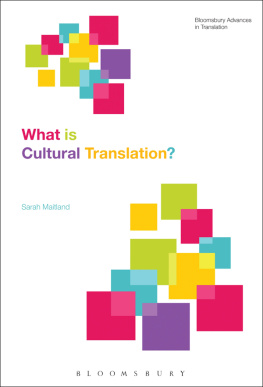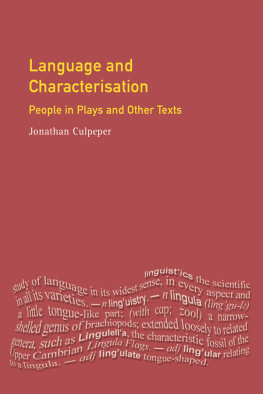Literature in Translation
TRANSLATION STUDIES
B RIAN J. B AER , E DITOR
Albrecht Neubert, Gert Jger, and Gregory M. Shreve, Founding Editors
1 Translation as Text
Albrecht Neubert and Gregory M. Shreve
2 Pathways to Translation: Pedagogy and Process
by Donald C. Kiraly
3 What Is Translation?: Centrifugal Theories, Critical Interventions
by Douglas Robinson
4 Repairing Texts: Empirical Investigations of Machine Translation Post Editing Processes
by Hans P. Krings
Edited by Geoffrey S. Koby
5 Translating Slavery, Volume I: Gender and Race in French Abolitionist Writing, 17801830
Edited by Doris Y. Kadish and Franoise Massardier-Kenney
6 Toward a Translation Criticism: John Donne
by Antoine Berman
Translated and edited by Franoise Massardier-Kenney
7 Translating Slavery, Volume II: Ourika and Its Progeny
Edited by Doris Y. Kadish and Franoise Massardier-Kenney
8 Literature in Translation: Teaching Issues and Reading Preactices
Edited by Carol Maier and Franoise Massardier-Kenney
Literature in Translation
Teaching Issues and Reading Practices
Edited by
C AROL M AIER
and
F RANOISE M ASSARDIER -K ENNEY
The Kent State University Press
KENT, OHIO
To Greg Shreve, for his unwavering support of so many in translation studies.
2010 by The Kent State University Press, Kent, Ohio 44242
All rights reserved
Library of Congress Catalog Card Number 2010023663
ISBN 978-1-60635-049-2
Manufactured in the United States of America
Library of Congress Cataloging-in-Publication Data
Literature in translation: teaching issues and reading practices / edited by Carol Maier and Franoise Massardier-Kenney.
p. cm. (Translation studies; 8)
Includes bibliographical references and index.
ISBN 978-1-60635-049-2 (alk. paper)
1. Translating and interpreting. 2. LiteratureStudy and teaching. I. Maier, Carol, 1943II. Massardier-Kenney, Franoise.
P 306.2. L 59 2010
418.02dc22
2010023663
British Library Cataloging-in-Publication data are available.
14 13 12 11 10 5 4 3 2 1
Contents
Carol Maier and Franoise Massaridier-Kenney
Carol Maier
Franoise Massardier-Kenney
Isabel Garayta
Yunte Huang
Rosemary Arrojo
Sergio Waisman
Ronald Christ
Tomoko Aoyama and Judy Wakabayashi
Michelle Yeh
Kathleen Ross
Niels Ingwersen and Susan C. Brantly, with Thomas A. Dubois and Dick Ringler
Christi A. Merrill
Paul Bandia
Kelly Washbourne
Brian James Baer
Allen Hibbard
Chana Bloch
Acknowledgments
A truly collaborative endeavor, Literature in Translation has benefited from numerous contributions during its conceptualization and preparation. We are grateful to several anonymous readers whose helpful comments and suggestions we considered carefully and heeded to the best of our ability. We also want to express our gratitude to Brent Winter for his meticulous copyediting. In addition, we want to offer our thanks to the chapter authors, not only for their essays but also for their continued support of our project; to Julianna Watson and Marlne Nativelle, for their work with formatting; and to the MFA students in the first Reading in Translation class, for their enthusiastic response to our pedagogical experiments with the translation-related issues and reading practices discussed in this volume.
Finally, we acknowledge a particular debt of gratitude to Susan C. Brantly for her help with the last revisions of the essay by Niels Ingwerson, of whose passing we learned as our manuscript was nearing completion. Although we never had the opportunity to meet Niels in person, we came to know and admire him through our many exchanges.
Introduction
Carol Maier and Franoise Massardier-Kenney
The last several decades have seen college and university students across the United States reading a wide variety of literary works from around the world, as literature in English translation has made its way onto the reading lists of courses in such disciplines and interdisciplines as anthropology, creative writing, ethnic studies, gender studies, philosophy, world literature, and sociology. On the one hand, this is cause for rejoicing. Students in this mostly monolingual society, which often forgets its own plurilingual origins and development, are still not learning foreign languages in sufficient numbers; but through translation, they are at least becoming acquainted with the multilingual world in which they live and in which they will work. Moreover, many world literature courses have expanded their reach. Starting from a conception of world literature as the teaching of great books culled from the literary canon of Europe and America, world literature is slowly becoming what David Damrosch has referred to as a mode of reading (281) that will allow students to engage with worlds that are beyond their own time and place. This expansion, which enables readers to become aware of other cultures and to connect them with their own, cannot but lead to an appreciation of linguistic diversity and alterity (Pizer 7).
However, the positive impact of reading books from other countries is not always maximized, because literature in English translation is often taught as if it had been originally written in English. This means that students may not be familiarized with the context in which that literature was produced and thus not made aware of the cultural, linguistic, and literary effects that translation involves. Although students may read foreign works, they submit them to their own cultural norms. If, as Roland Greene has suggested, we must learn to live with translation strategically, it is crucial that instructors and students understand both the context of the original work and the principal issues of literary translation (Feal 5). Without such an understanding, students read translated material, but they do not read in translation, and the benefits of intercultural communication may be jeopardized. It is not enough for books from other languages and countries to be available in translation; the positive contact that literature in translation can offer must be fully exploited if readers are not, in the words of William Deresiewicz, to impose their own image on the world (23).
Here a true challenge arises for an instructor. All too frequently, books in translation contain no introductory information about the mediation that translation invariably implies or about the stakes involved in the transfer of another culture into English. Nor can one count on finding suggestions for further reading about the author or the culture of the source text. Instructors are often left on their own; lacking the appropriate pedagogical tools, they may find themselves unable to provide information about either the original work or about translation itself. They may also feel uneasy about teaching material for which they lack adequate preparation; in fact, they may believe that it is neither professional nor ethical to do so (see Arrojo, Rose, and Maier). Consequently, they may restrict themselves to teaching well-known works in translation with which they are already familiar, or work originally written in English, when available (as in the case of literature from Africa or India).
Next page
